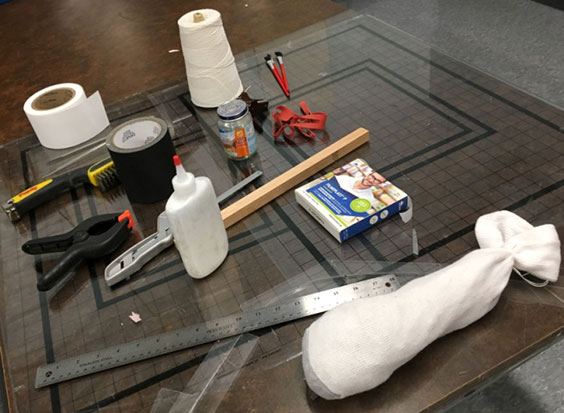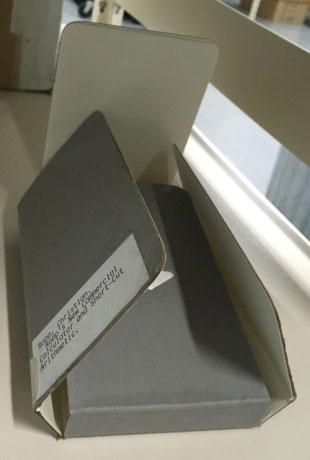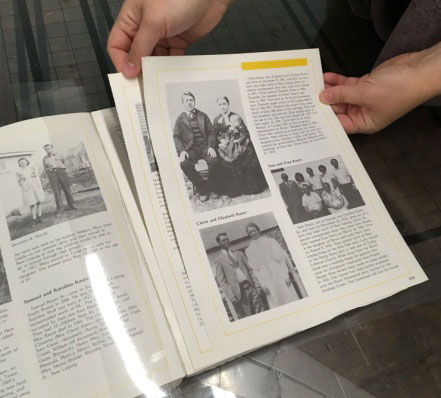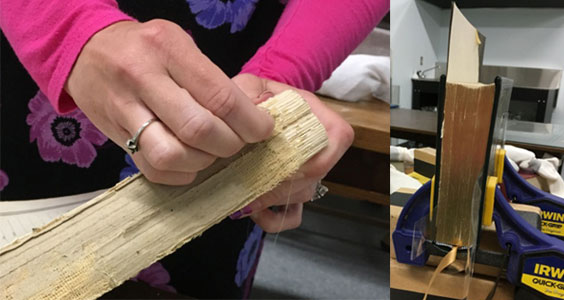Where do you go if you have need of book repair? Since we are an archives, and we are known for having books (North Dakota related, of course), patrons ask us this question quite frequently.

Reference Specialist Sarah Walker holds a book mid-repair process. The original binding has been removed and strengthened for when the book block will be reattached.
Although we do not repair books here at the State Archives as a service for our patrons, we do actually conduct limited in-house book repairs for some of our most heavily used and damaged books to extend their shelf life (literary pun intended!). These are patch and repair, triage-style fixes, leaving behind scars. We keep the repairs as archival quality as we can (when using tape, glue, paper, and cardboard), but this is not restoration. This is survival.
However, it can also be super fun!

Some tools of the trade are pictured here. Rubber bands; metal brushes; saws; glue; archival-quality, double-sided tape; clamps; string; paint brushes; a ruler; and a sock (used as a weight—it is filled with lead pellets) are all used in some capacity in our “workshop.” The white roll is a material called cambric, used to cover the spine and glue the book block back into the binding. We put small amounts of glue into baby food jars so we don’t have to leave larger bottles open, and then we apply glue with paintbrushes.
I learned some simple book-binding tricks and tips many years ago (or, what feels like it, anyway) from a gentleman who volunteered to teach our staff. There were several of us at the outset. Now, I am the only remaining staff member working on our books from this first instruction. However, our staff has kept the process going by working with each other and sharing the information.
Virginia Bjorness, cataloger, and Stephanie Baltzer Kom, head of technical services, are my book-binding buddies these days. We meet approximately once a month for about an hour and go through the tattered vessels that have been pulled from any of our various shelves.
We complete several steps to determine what is to be done, as not all books must be repaired equally.

This is a phase box. Made of a stiff cardboard, it protects everything inside of it by acting as a hard shell.
First, we determine whether the book should be put into a phase box instead of going through repairs. Using a phase box will protect the book as is. There are merits to this; it will maintain some historical integrity of the object (if this is important to the book). Also, sometimes the paper is too fragile to work with, or the repairs necessary are too numerous and would not improve ease in using the book. These books need a phase box and will be set aside for that purpose.
Once the book has been determined as free-for-repair, one of us examines it. What issues does it have? Are the pages merely falling out? Is the binding tearing? Is the book pulling in half? All of these are typical problems we see quite frequently in books of every age.
Then we look at the book to see what style it is. Does it have a flat binding? Are the pages glued directly to the binding?

Head of Technical Services Stephanie Baltzer Kom displays a book with loose pages falling out.
Now it is time to fix it. Some fixes are pretty simple. For example, if a book’s pages are falling out, but the rest of the binding is fine, typically all we need to do is tip, or glue, the pages in. We apply a thin strip of glue on the binding-side edge of the page that has fallen out, as well as the following page, and then put the glue together, keeping the page as even with the rest of the book block as possible. We sometimes put strips of plastic between pages to keep them from getting glued to everything—glue is essential!
Some fixes are more time-consuming and involved. These tend to be my favorite. They frequently involve stripping the book block from the book and redoing the binding. This is more typical of books that have a rounded spine rather than a flat spine. Maybe the book block pulls out of the binding, ripping a page or two. In this instance, we might even have to apply a fix to the book block itself and tip a few pages back in, as well as work with the binding.
First, we must work with the book block. We pull the book block from the binding, put it between two bricks, and fully remove any excess materials of glue and fabric from the spine. We peel it by hand, cut it away, or even sand it. After this is done, we might be able to simply tip or glue the pages together, and then spread glue across the entire spine to make a glue binding to keep everything together. This is set aside.
Sometimes we have to restring the spine. This is my favorite part! After the book block is cleaned as best as we can, we use a small handheld saw to cut several shallow stripes into the spine of the book block. We add copious amounts of glue, again. Then we cut strings and squeeze them into those stripes. We clamp everything in place and tighten the strings. (I add more glue after this, just to be sure.) Then we let it dry. Voila! In the morning (or in the next month, when we are back together), it is just a matter of laying the block into the book, finishing up the edges, and gluing everything together.
If it is a flat spine and the binding is toast, we might use tape to recreate what was there. This is a special, much more hearty kind of tape (think duct tape in quality, leather-bound book in texture, and imagine “old library” to get the right color. Though to be honest, we mainly just have it in black.) We measure the covers and the book block, place the covers on the either edge of the tape, and tape them back to the clean, dry book block.

Left: Sarah Walker peels back fabric that must be removed before this book block can be put back into its cover.
Right: This book is clamped in place to dry. It had been torn from its binding but will soon be in one piece again.
Book repair is subjective, so we often confer with each other on these more difficult books. Sometimes we try something to see if it will work—and sometimes, we see these books return to us for more repairs. Quite frankly, we sometimes accidentally glue the pages in the wrong section, upside down, or to each other. Book repair can be complicated.
It’s also, in my opinion, a creative outlet, a stress release (especially when you get to use the saw on the book), and it is useful for maintaining readable books that our researchers can access and use.
So, to come full circle, where do patrons take their books for repair? We can brainstorm a few ideas for the patron who might prefer to send their books to a professional. However, although what we do is not preservation, and isn’t always pretty, it really does help the book survive. If any patrons would like to try their hand at repairing their own books, we are happy to provide some helpful tips. Feel free to contact us at archives@nd.gov!

